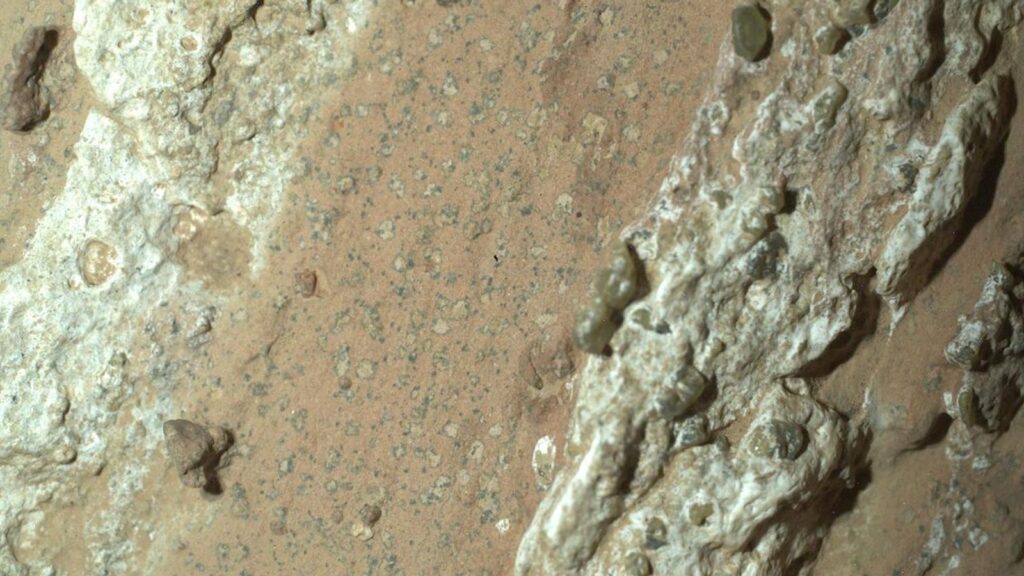Life on Mars Evidence has taken a groundbreaking leap forward as NASA scientists reveal that unusual “leopard spots” found on a Martian rock may represent the clearest sign yet that microbial life once existed on the red planet. The discovery comes from the Perseverance rover, which has been exploring Mars’ Jezero Crater since 2021, searching for biosignatures that could answer one of humanity’s oldest questions: Are we alone in the universe?
NASA officials announced that a detailed year-long analysis of the mysterious markings — which look like black leopard-like spots on the rock’s surface — revealed a combination of minerals that, on Earth, often form as a byproduct of microbial activity. Though scientists cannot completely rule out a non-biological explanation, the evidence is so compelling that it represents the most significant sign of possible past life ever detected on Mars.
A Discovery Years in the Making
The Perseverance rover, a 3-meter-long robotic explorer, has been methodically scanning Mars’ Jezero Crater, a site chosen because it once hosted an ancient river delta and standing bodies of water more than 3 billion years ago. These wet environments are thought to have been ideal for microbial life.
In July of last year, Perseverance encountered a striking rock NASA dubbed “Cheyava Falls,” lying in a canyon that was carved out by flowing water billions of years ago. Upon closer inspection, the rover’s cameras captured unusual circular black spots across the rock surface, resembling leopard skin patterns. NASA scientists immediately flagged it as a priority target for deeper study.
Over the following months, Perseverance used its onboard instruments to perform detailed analysis. Spectroscopic scans revealed the presence of iron, phosphorus, and sulfur — elements that, on Earth, are frequently associated with biological processes. The black “poppy seed” textures in particular suggested microbial involvement in forming these minerals.
NASA’s Statement: The Closest We’ve Come to Finding Ancient Life
Nicky Fox, associate director of NASA’s science mission directorate, summarized the significance of the finding:
“This discovery by our incredible Perseverance rover is the closest we’ve actually come to discovering ancient life on Mars. We’re really excited about that. But it’s a signature — a leftover sign. It’s not life itself.”
In other words, Perseverance has not discovered living organisms but rather evidence that points to their possible existence in Mars’ distant past. These biosignatures were likely preserved when Mars still had liquid water and a thicker atmosphere, conditions that could have supported microbial life.
The Geological Mystery
Scientists are careful to emphasize that natural, abiotic geological processes can sometimes produce similar chemical signatures. To ensure the findings are robust, NASA researchers have been “pressure-testing” the data for over a year, comparing it against multiple hypotheses.
The rock samples taken from Cheyava Falls are currently stored in Perseverance’s onboard cache. NASA’s ultimate goal is to bring these samples back to Earth through a future Mars Sample Return mission, allowing scientists to examine them with more advanced laboratory equipment.
However, budget cuts and delays — including reductions to NASA’s funding during the Trump administration — have forced a rethink of how and when the joint NASA–ESA retrieval mission will launch. Despite this, acting NASA chief Sean Duffy said he is confident they can accomplish the mission with the current budget.

Ancient Mars: A Planet of Lakes and Rivers
The discovery also highlights how dramatically Mars has changed over the last three billion years. The Jezero Crater, once filled with rivers and possibly even lakes, is now a dry, dusty plain. Scientists believe Mars lost most of its atmosphere, causing surface water to evaporate into space and leaving behind a cold, barren landscape.
The minerals found within the leopard spots are believed to have formed in the presence of liquid water, suggesting that microbial life may have thrived there before the planet became inhospitable. The study of these mineral deposits provides clues about the planet’s habitability window — the time period when Mars could have supported life.
5 Key Findings Strengthening Life on Mars Evidence
- Leopard-Spot Pattern on Rock: The unusual visual pattern is unlike anything typically seen on Mars, prompting immediate scientific interest.
- Presence of Biologically Relevant Elements: Iron, phosphorus, and sulfur were all detected, commonly linked to microbial metabolisms on Earth.
- Geological Context: The rock was discovered in an ancient river delta, an ideal location for preserving potential biosignatures.
- Year-Long Verification: NASA scientists spent over 12 months cross-verifying results to rule out contamination or instrument errors.
- Sample Return Potential: These samples are now prime candidates for return to Earth, which would allow scientists to definitively confirm or reject the biological origin hypothesis.
Implications for the Search for Life Beyond Earth
If confirmed, this would be a historic milestone: the first direct evidence that life once existed beyond our planet. Such a finding would prove that Earth is not unique and that life could be a common outcome in the universe under the right conditions.
NASA scientists point out that every star in the night sky likely has at least one planet orbiting it, based on current astronomical data. If life once arose on Mars, it greatly increases the chances that life could emerge elsewhere, including potentially on exoplanets orbiting distant stars.
This discovery could also inform future missions, such as crewed Mars expeditions, by guiding where to search for additional biosignatures or even preserved microbial fossils.
Source: Sky News


